I woke up Friday morning not feeling very well. I had gone to bed feeling fine, woke up around 3:00 a.m. and drank some water and by 7:00 a.m. felt pretty lousy. Fortunately, we were not leaving until 10:00 a.m. so I was able to get a little more sleep before we met Liam for our trip around Slea Head Drive, a circular route beginning and ending in Dingle that forms part of the Wild Atlantic Way. There are a number of sites to see as well as incredible views of the most western part of Europe. We were going to travel clockwise on the route in order to avoid the large tour buses that travel the route during the summer.

Before we began the drive, Liam suggested we stop and visit the Dingle Crystal company operated by “master craftsman” Sean Daly who hand cuts each and every piece. I wasn’t sure what to expect and in my state, wasn’t particularly interested, but once again Liam proved me wrong. Sean was a lovely engaging bear of a man and he provided us with a demonstration of how he hand cuts the crystal using machinery and water. He started with a small crystal cup and proceeded to cut the crystal with pin point precision while three of us stared over his shoulder. Absolutely brilliant. Cheryl and Donnie ended up buying a large candle holder from Sean’s beehive collection.
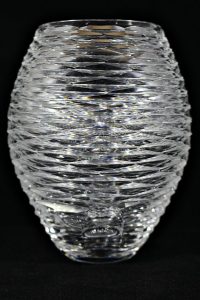
So after the quick detour, we began our trip around the 47 km Slea Head Drive. As we left Dingle and began to follow the VERY narrow road along the Atlantic Ocean, waves crashed along the rocks along the shore line and rain began to hit the windshield. Fortunately, the rain was short lived, but the cold wind would be with us for the duration of the trip.

We passed the little village of Ventry and made our first stop about 20 minutes into the drive where Liam pointed to the ruins of Dún Beag Fort believed to be more than 2,500 years old. Unfortunately, a storm this past January took out some of the stone ruins and the site has been closed. The best we could do was take a picture from a short distance away.
After the picture stop, we jumped into the van and drove a few more minutes, past an amazing “V” shaped bend in the road (no idea how buses make the curve) and then up the hillside to our next stop, the “beehive huts”, which are a national heritage site. The beehive huts are believed to have been occupied by the Celts and date back to the 6th century. The complex of clochauns, (the formal name for the stone beehive-shaped buildings), sat on the southern slope of Mt. Eagle overlooking Dingle Bay. The setting was absolutely spectacular.


We wandered around the huts and were able to go inside a couple that no longer had the conical roofs. Nevertheless, we were able to see up close the intricate piecing of the rocks to form the structure. It was really something else to think how old the “hives” were and how much they have withstood. Now the really interesting thing was that the hives stand in the middle of a farm. So there were sheep, lambs and boarder collies everywhere. Because it is a national heritage site, the farm must co-exist with the hives.
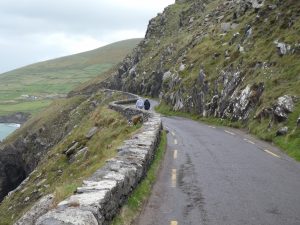

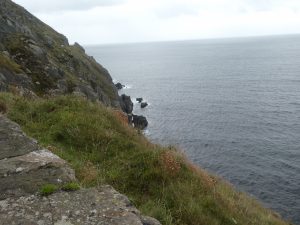
Once back in the car, Liam said that he would drive a short distance and then let us out of the vehicle for a walk along the road and up the hill. At this point, we were close to Dunmore Head which is the most westerly point on the Slea Head Drive. So we bundled up, jumped out and proceeded to walk up the windy narrow road making sure to jump out of the way of cars coming up behind us. The view of the Blasket Islands and the rest of the peninsula was absolutely stunning as we walked. Various species of seagull were blown around in the wind as they dove towards the water and back up. The water crashed on the rocks. It was the epitome of the Wild Atlantic Way.
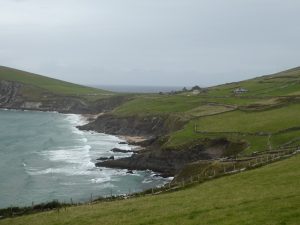
Once we met up with Liam, we drove a few more minutes before we stopped at a little road side stand high above the Atlantic Ocean where a young woman was selling home made cookies. I think the more appropriate term would be home made bars. I chose the raspberry oat bar, Cheryl had ginger almond and Donnie had a brownie. Now while my stomach was still doing somersaults, there was nothing that was going to keep me from eating that raspberry oat bar. It as homemade deliciousness.
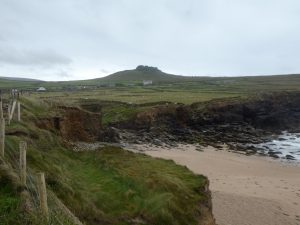
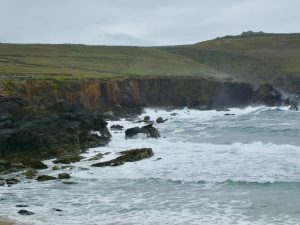
After the morning food break, we drove around the bend in the road through some farm lands and down a narrow little lane to Coumenoole Strand, a massive beach that is dangerous to swim because of the heavy currents and undertow. Apparently portions of the 1992 film Ryan’s Daughter was filmed at the location. The beach was surrounded by cliffs and farm land making for quite the dramatic views.

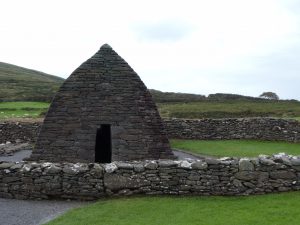
After the brief stop, we drove back to the main road and followed a path that took us a bit inland through more farming area to our next stop the Gallarus Oratory a stone building that dates to the 7th or 8th century. Now depending upon who you believed, Liam or the comments of others at the site, the Oratory was either used as a church or as a resting place for pilgrims. In any event, the building was really incredible and built in the same method as the building we saw at New Grange (although that structure was centuries older). And like the other ancient structures we had viewed today, this one also bordered a farm with the ever present sheep always nearby.
We were able to go inside the structure and see how the stones were placed together and stabilized with smaller stones. And just like New Grange, the placement and angle of the stones made the interior of the structure waterproof. It was simply amazing to think how old the building was and how rainy this Sleigh Head area is; yet not a single drop of water had penetrated the building. Incredible.

Our last stop on our Slea Head Drive was to the Kilmalkedar Church, an ancient stone church believed to have been built in the mid 12th century (although remnants of previously built structures on the site date to the 600s). This stone church was significant, in my opinion, because it was the first time I can recall seeing touches of Roman architecture in an ancient Irish building.
As we wandered around the ruins, we encountered an early stone sundial, remnants of a stone high cross and an ogham stone, which is a stone containing Celtic carvings in the shape of lines and dashes that constitute an alphabet. We saw examples of these in the Trinity Library at the Book of Kells exhibit.

Liam also directed us to a large free standing stone with a hole in the center top. Liam told us this was a promise stone. The hole in the stone was narrow on one side and wide on the other. In ancient times, when a man and woman wanted to be married, the man would put his hand through the wide side and the woman would put her hand through the narrow side and they made their marriage promise while there hands were connected in the hole. Liam insisted that Cheryl and Donnie renew their vows so wedding number 2 took place at the ruins of Kilmalkedar Church and the surrounding cemetery.

By now it was close to 2:00 p.m. The drive back to our B&B was short. Cheryl and Donnie wanted to go for lunch and I wanted to go to bed. So I backed out of the rest of the day and Cheryl and Donnie were off for lunch and exploring Dingle. By 7:30 (the time for our dinner reservation in town) I was still not feeling 100% so opted to spend the night in. I am sure Cheryl and Donnie will have some fun stories to tell about the bars and the little shops they visited. Unfortunately, I had to sit this one out.
